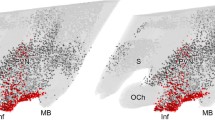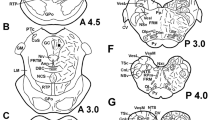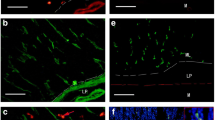Abstract
Pituitary adenylyl cyclase activating peptide (PACAP) is a novel hypothalamic peptide that is widely distributed in neurons, including those of the gastrointestinal tract. In this study, a polyclonal antiserum directed against PACAP-27 was used to investigate the localisation of PACAP throughout the gut and to determine the projections of PACAP-immunoreactive (IR) neurons in the guinea-pig small and large intestines. PACAP-IR fibres were seen in the myenteric and submucous plexuses, in the longitudinal and circular muscle layers and around blood vessels of the submucosa throughout the gut. In both the small and large intestine, PACAP-IR cell bodies, most with Dogiel type-I morphology, were seen in the myenteric ganglia following colchicine treatment. Lesion studies (myotomy and myectomy operations) revealed that PACAP-IR interneurons projected anally in the ileum and colon. Myectomy operations resulted in a loss of PACAP-IR fibres in the circular muscle under the operation, whereas PACAP-IR fibres remained in the submucosa and around blood vessels. Following extrinsic denervation of the ileum, the number of PACAP-IR fibres in the submucosal ganglia and around blood vessels decreased. This suggests that a portion of PACAP-IR fibres supplying the submucosal ganglia and blood vessels have an extrinsic source. To investigate this, immunohistochemical studies were performed on sympathetic and dorsal root ganglia. Numerous reactive cells were seen in the dorsal root ganglia, but none was seen in sympathetic pre- or paravertebral ganglia.
Similar content being viewed by others
References
Arimura A, Somogyvari-Vigh A, Miyata A, Mizuno K, Coy DH, Kitada C (1991) Tissue distribution of PACAP as determined by RIA: highly abundant in the rat brain and testes. Endocrinology 129:2787–2789
Christofi FL, Wood JD (1993) Effects of PACAP on morphologically identified myentric neurons in guinea pig small bowel. Am J Physiol 264:G414-G421
Costa M, Furness JB, Llewellyn-Smith IJ, Cuello AC (1981) Projections of substance P-containing neurons within the guineapig small intestine. Neuroscience 6:411–424
Costa M, Brookes SA, Waterman S, Mayo R (1992a) Enteric neuronal circuitry and transmitters controlling intestinal motor function. In: Holle GE (ed) Advances in the Innervation of the Gastrointestinal Tract. Elsevier, Amsterdam New York, pp 115–121
Costa M, Furness JB, Pompolo S, Brookes SJH, Bornstein JC, Bredt DS, Snyder SH (1992b) Projections and chemical coding of neurons with immunoreactivity for nitric oxide synthase in the guinea-pig small intestine. Neurosci Lett 148:121–125
Furness JB, Bornstein JC (1994) The enteric nervous system and its extrinsic connections. In: Yamada T (ed) Textbook of Gastroenterology (in press)
Furness JB, Costa M (1982) Neurons with 5-hydroxytryptamine-like immunoreactivity in the enteric nervous system: their projections in the guinea-pig small intestine. Neuroscience 7:341–349
Furness JB, Costa M (1987) The enteric nervous system. Churchill Livingston, Edinburgh
Gibbins IL, Furness JB, Costa M, MacIntyre I, Hillyard CJ, Girgis S (1985) Co-localization of calcitonin gene related peptide-like immunoreactivity with substance P in cutaneous, vascular and visceral sensory neurons of guinea-pigs. Neurosci Lett 57:125–130
Grider JR, Murthy KS, Jin J-G, Makhlouf GM (1992) Stimulation of nitric oxide from muscle cells by VIP: prejunctional enhancement of VIP release. Am J Physiol 262:G774-G778
Katsoulis S, Clemens A, Schwörer H, Creutzfeldt W, Schmidt WE (1993) PACAP is a stimulator of neurogenic contraction in guinea pig ileum. Am J Physiol 265:G295-G302
Kimura C, Ohkubo S, Ogi K, Hosoya M, Itoh Y, Onda H, Miyata A, Jiang L, Dahl RR, Stibbs HH, Arimura A, Fujino M (1990) A novel peptide which stimulates adenylate cyclase: Molecular cloning and characterization of the ovine and human cDNAs. Biochem Biophys Res Commun 166:81–89
Köves K, Arimura A, Somogyvari-Vigh A, Vigh S, Miller J (1990) Immunohistochemical demonstration of a novel hypothalamic peptide, pituitary adenylate cyclase-activating polypeptide, in the ovine hypothalamus. Endocrinology 127:264–271
Köves K, Arimura A, Görcs TG, Somogyvari-Vigh A (1991) Comparative distribution of immunoreactive pituitary adenylate cyclase activating polypeptide and vasoactive intestinal polypeptide in rat forebrain. Neuroendocrinology 54:159–169
Köves K, Arimura A, Vigh S, Somogyvari-Vigh A, Miller J (1993) Immunohistochemical localization of PACAP in the ovine digestive system. Peptides 14:449–455
Llewellyn-Smith IJ, Costa M, Furness JB, Bornstein JC (1993) Structure of the tertiary component of the myenteric plexus in the guinea-pig small intestine. Cell and Tissue Res 272:509–516
Masuo Y, Suzuki N, Matsumoto H, Tokito F, Matusmoto Y, Tsuda M, Fujino M (1993) Regional distribution of pituitary adenylate cyclase activating polypeptide (PACAP) in the rat central nervous system as determined by sandwich-enzyme immunoassay. Brain Res 602:57–63
Matthews MR, Cuello AC (1982) Substance P-immunoreactive peripheral branches of sensory neurons innervate guinea pig sympathetic neurons. Proc Natl Acad Sci USA 79:1668–1672
McConalogue K, Furness JB, Vremec MA, Holst JJ, Tornoe K, Marley PD (1994) Histochemical, pharmacological, biochemical and chromatographic evidence that pituitary adenylyl cyclase activating peptide is involved in inhibitory neurotransmission in the taeniae of the guinea-pig caecum. J Autonom Nerv Syst (in press).
Miyata A, Arimura A, Dahl RR, Minamino N, Uehara A, Jiang L, Culler MD, Coy DH (1989) Isolation of a novel 38 residuehypothalamic polypeptide which stimulates adenylate cyclase in pituitary cells. Biochem Biophys Res Commun 164:567–574
Miyata A, Jiang L, Dahl RD, Kitada C, Kubo K, Fujino M, Minamino N, Arimura A (1990) Isolation of a neuropeptide corresponding to the N-terminal 27 residues of the pituitary adenylate cyclase activating polypeptide with 38 residues (PA-CAP38). Biochem Biophys Res Commun 170:643–648
Moller K, Zhang Y-Z, Håkanson R, Luts A, Sjölund B, Uddman R, Sundler F (1994) Pituitary adenylate cyclase activating peptide is a sensory neuropeptide: immunocytochemical and immunochemical evidence. Neuroscience 57:725–732
Mungan Z, Rossowski WJ, Coy DH (1991) Pituitary adenylate cyclase activating polypeptide relaxes gastrointestinal smooth muscles in rat. Clin Res 39:236A
Ogi K, Kimura C, Onda H, Arimura A, Fujino M (1990) Molecular cloning and characterization of cDNA for the precursor of rat pituitary adenylate cyclase activating polypeptide (PA-CAP). Biochem Biophys Res Commun 173:1271–1279
Ohkubo S, Kimura C, Onda H, Miyata A, Arimura A, Fujino M (1992) Primary structure and characterization of precursor to human pituitary adenylate cyclase activating polypeptide. DNA Cell Biol 11:21–30
Schwörer H, Clemens A, Katsoulis S, Kohler H, Creutzfeldt W, Schmidt WE (1993) Pituitary adenylate cyclase activating peptide is a potent modulator of human colonic motiligy. Scand J Gastroenterol 28:625–632
Shen Z, Larsson LT, Malmfors G, Absood A, Håkanson R, Sundler F (1992) A novel neuropeptide pituitary adenylate cyclase-activating polypeptide (PACAP), in human intestine: evidence for reduced content in Hirschsprung's disease. Cell Tissue Res 269:369–374
Stark ME, De Martino C, Zamboni L (1967) Fixation of ejaculated spermatozoa for electron microscopy. Nature 216:173–174
Stefanini M, De Martino C, Zamboni L (1967) Fixation of ejaculated spermatozoa for electron microscopy. Nature 216:173–174
Sundler F, Ekblad E, Absood A, Håkanson R, Köves K, Arimura A (1992) Pituitary adenylate cyclase activating peptide: a novel vasoactive intestinal peptide-like neuropeptide in the gut. Neuroscience 46:439–454
Tatsuno I, Gottschall PE, Köves K, Arimura A (1990) Demonstration of specific binding sites for pituitary adenylate cyclase activating polypeptide (PACAP) in rat astrocytes. Biochem Biophys Res Commun 168:1027–1033
Vigh S, Arimura A, Köves K, Somogyvari-Vigh A, Sitton J, Fermin CD (1991) Immunohistochemical localization of the neuropeptide, pituitary adenylate cyclase activating polypeptide (PACAP), in human and primate hypothalamus. Peptides 12:313–318
Wardell CF, Bornstein JC, Furness JB (1994) Projections of 5-hydroxytryptamine-immunoreactive neurons in guinea-pig distal colon. Cell Tissue Res 278:379–387
Zhang Y-Z, Sjölund B, Moller K, Håkanson R, Sundler F (1993) Pituitary adenylate cyclase activating peptide produces a marked and long-lasting depression of a c-fibre-evoked flexion reflex. Neuroscience 57:733–737
Author information
Authors and Affiliations
Rights and permissions
About this article
Cite this article
Portbury, A.L., McConalogue, K., Furness, J.B. et al. Distribution of pituitary adenylyl cyclase activating peptide (PACAP) immunoreactivity in neurons of the guinea-pig digestive tract and their projections in the ileum and colon. Cell Tissue Res 279, 385–392 (1995). https://doi.org/10.1007/BF00318496
Received:
Accepted:
Issue Date:
DOI: https://doi.org/10.1007/BF00318496




